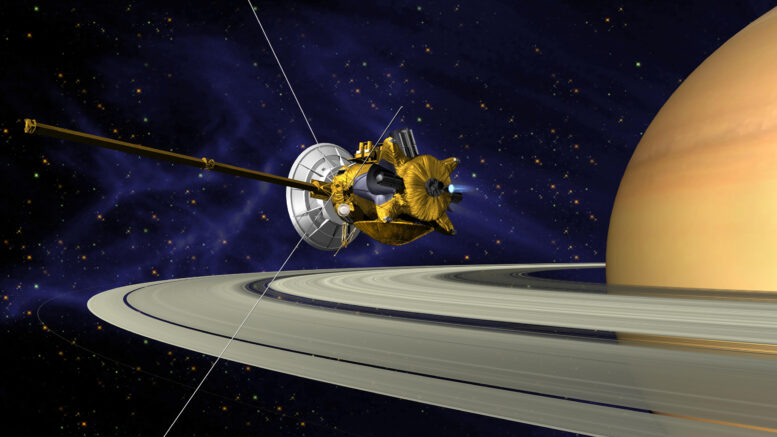So far there have only been a total of 4 spacecraft to study the planet Saturn. Of the 4 spacecraft to study the planet 3 spacecraft visited as flybys, whereas there has only been 1 mission to study and visit Saturn for its entire lifespan.
Pioneer 11 flyby
A 259-kilogram or 571 pound robotic space probe launched by NASA on April 6, 1973 to study the asteroid belt, the environment around Jupiter and Saturn, solar wind and cosmic rays.[1] Pioneer 11 made the first flyby of Saturn in September 1979, when it passed within 20,000 km of the planet’s cloud tops.
Images were taken of the planet and a few of its moons, although their resolution was too low to discern surface detail. The spacecraft also studied Saturn’s rings, revealing the thin F-ring and the fact that dark gaps in the rings are bright when viewed at high phase angle (towards the Sun), meaning that they contain fine light-scattering material. In addition, Pioneer 11 measured the temperature of Titan.[2]
Voyager 1 Flyby
In November 1980, the Voyager 1 probe visited the Saturn system. It sent back the first high-resolution images of the planet, rings, and satellites. Surface features of various moons were seen for the first time. Because of the earlier discovery of a thick atmosphere on Titan, the Voyager controllers at the Jet Propulsion Laboratory elected for Voyager 1 to make a close approach of Titan. This greatly increased knowledge of the atmosphere of the moon, but also proved that Titan’s atmosphere is impenetrable in visible wavelengths, so no surface details were seen.
Voyager 2 Flyby
in August 1981, Voyager 2 continued the study of the Saturn system. More close-up images of Saturn’s moons were acquired, as well as evidence of changes in the rings. Voyager 2 probed Saturn’s upper atmosphere with its radar, to measure temperature and density profiles. Voyager 2 found that at the highest levels Saturn’s temperature was 70 K, while at the deepest levels measured the temperature increased to 143 K. The north pole was found to be 10 K cooler, although this may be seasonal. Unfortunately, during the flyby, the probe’s turnable camera platform stuck for a couple of days and some planned imaging was lost. Saturn’s gravity was used to direct the spacecraft’s trajectory towards Uranus. The probes discovered and confirmed several new satellites orbiting near or within the planet’s rings. They also discovered the small Maxwell and Keeler gaps in the rings.
Cassini–Huygens spacecraft
The Cassini-Huygens spacecraft included tools including, but not limited to Infrared, imaging technologies in the ultraviolet ranges, a plasma spectrometer, dust analyzer, ion and neutral mass spectrometer, magnetometer, as well as radio and plasma wave analysis. [3]
Upon the Huygens probe making its first landing on the moon Titan, the probe became the first spacecraft to land on a moon in the outer solar system. During the time spent on Titan, important findings included methane rain, erosion and drainage channels and dry lake beds. A soup of complex hydrocarbons, including benzene, was found in Titan’s atmosphere. A very surprising find was water based icy plumes on the moon Enceladus. Plus, with the length of time it observed the rings of Saturn, Cassini was able to view the potential formation of a new plus how the rings evolve over time. Plus, the study of the atmospheres of Saturn and Titan have made many new insights about the compositions of the planets and how they behave.
Future Missions
There have been proposed missions to Saturn and the moons, but none have yet come to fruition. Hopefully more missions will be launchd going forward.
To learn about observations of Saturn and how to view the planet yourself, check out this article. Check out the Planetary Bodies Category for previous and upcoming articles on the solar system planets.
Sources
[1] = Fimmel, R. O.; Swindell, W.; Burgess, E. Pioneer Odyssey. SP-349/396. Washington, D.C.: NASA-Ames Research Center. OCLC 3211441. Retrieved January 9, 2011.
[2] = “The Pioneer 10 & 11 Spacecraft”. Mission Descriptions. Archived from the original on 30 January 2006. Retrieved 5 July 2007.
[3] = “Cassini: Mission to Saturn: Cassini Orbiter”.
https://solarsystem.nasa.gov/news/12892/cassini-10-years-at-saturn-top-10-discoveries/

Be the first to comment on "Scientific Missions And Discoveries Of Saturn"